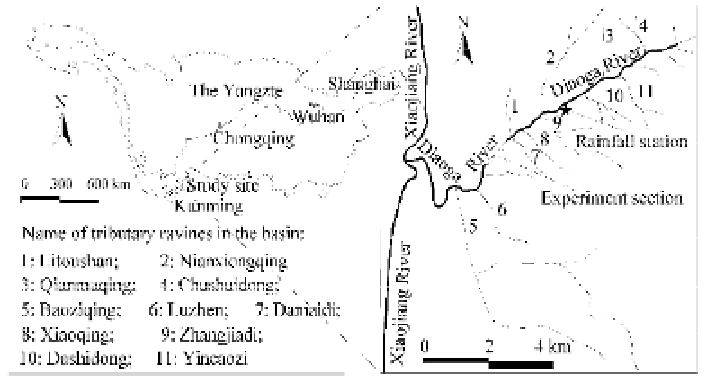Environmental Engineering Reference
In-Depth Information
streams with boulders and cobbles, bays by the river, riparian lakes and wetlands, and backwater and
sluggish flow zones. Artificial step-pool systems may be used for integrated mountain stream management
to achieve incision control, hazard mitigations and ecology improvement or restoration. Reforestation
with selected wood species and diverse local understory species is beneficial both for soil erosion control
and terrestrial ecology. If the pollution is controlled below a critical level, a river ecosystem consisting of
diverse aquatic plants and benthic faunal communities may consume nutrients and organic pollutants and
purify the water.
11.3.1 Hazard Mitigation, and Ecology Restoration With Artificial Step-Pool System
River bed incision causes bank failures, landslides, and debris flows on many rivers in southwestern
China. The stream ecology is also seriously impaired due to lack of stable habitats. The Diaoga River is a
tributary of Xiaojiang River, which is an upstream tributary of the Yangtze River (Fig. 11.52). It originates
from Huangcaoling Mountain (elevation 2708 m) on Yunnan-Guizhou Plateau in southwestern China,
prior to joining the Xiaojiang River (elevation 1490 m). The average gradient of the river bed is about
9.6%. This small mountain stream has a main channel length of 12 km and a drainage area of about 54 km
P
2
P
.
The basin lithology is generally comprised of shales, siltstones, and sandstones and the dominant plants
includes eucalyptus, pine tree, sisal, chestnut and walnut tree.
Fig. 11.52
Experiment location on the Diaoga River
The Diaoga River is seriously incised because of the high bed gradients. Bed incision has caused
serious bank failures, slope and rill erosion, and induces landslide and debris flow events. The stream
ecosystem is impaired and the aquatic habitats are frequently damaged or destroyed by landslides, debris
flows, and intensive bed load transportation. The environment of the mountain stream has gradually
degraded in recent decades. The average annual sediment yield is around 3000 t/km
P
2
P
·yr
P
(Lv, 2000). The
annual average precipitation is about 1000 mm. Most of this falls as rain during the flood season mainly
between July and August. Localized thunderstorms with precipitation intensities greater than 35-55
mm/day are common in summer. Sediment transportation in the stream is intensive because plenty of
sediment is fed into the stream by landslides and debris flows. Human activities also increase soil erosion
to some extent. In most river sections, there are no natural step-pools. The relatively uniform and
homogenous stream habitat and bed instability provide poor habitats for benthic bio-communities and the
stream has quite low biodiversity.
An experiment was conducted on the river for incision control, mitigation of landslides and debris


Search WWH ::

Custom Search